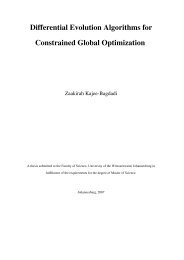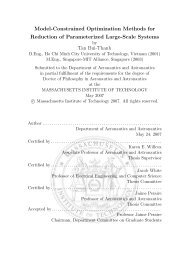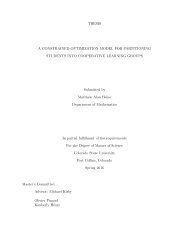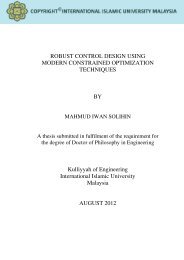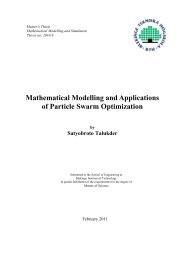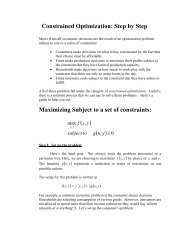Application of Genetic Algorithm in Multi-objective Optimization
You also want an ePaper? Increase the reach of your titles
YUMPU automatically turns print PDFs into web optimized ePapers that Google loves.
List <strong>of</strong> Illustrations<br />
Figure 3.1: (a) Top view and (b) Isometric view <strong>of</strong> the <strong>in</strong>determ<strong>in</strong>ate plate…………………….…45<br />
Figure 3.2: (a) Balanced reactive forces with smaller enclosed area and (b) Bigger enclosed area with<br />
unbalanced reactive forces………………………………………………………………………46<br />
Figure 3.3: (a) Location <strong>of</strong> three supports which generates an area on the surface (b) heuristically<br />
calculated maximum possible area with equal reaction forces <strong>in</strong> all<br />
supports…………………………………………………………………………………...……50<br />
Figure 3.4: Modified test case with circular discont<strong>in</strong>uities…………………………………...…..53<br />
Figure 4.1: (a) Differences among reactive forces and (b) enclosed area by support locations for<br />
“Cont<strong>in</strong>uous Method”………………………………………………………………………….58<br />
Figure 4.2: Optimum <strong>objective</strong> value obta<strong>in</strong>ed by us<strong>in</strong>g “Cont<strong>in</strong>uous Method” from 30<br />
runs…………………………………………………………………………………………….59<br />
Figure 4.3: Solution space for (a) cont<strong>in</strong>uous method and (b) discretized method………………60<br />
Figure 4.4: Optimum <strong>objective</strong> value obta<strong>in</strong>ed by us<strong>in</strong>g two<br />
methods………………………….……………………………………………………………..64<br />
Figure 4.5 (a) Distribution <strong>of</strong> optimal area value and (b) reaction differences by two<br />
methods………………………………………………………………………………………...65<br />
Figure 4.6: Graph <strong>of</strong> m<strong>in</strong>imum (best) <strong>objective</strong> value vs generation number for cont<strong>in</strong>uous and<br />
discretized method……………………………………………………………………………..67<br />
Figure 4.7: Indeterm<strong>in</strong>ate structure with (a) previous discont<strong>in</strong>uous areas (b) 25% <strong>in</strong>creased circular<br />
discont<strong>in</strong>uities and (c) 50% <strong>in</strong>creased circular discont<strong>in</strong>uities…………………………………..69<br />
Figure 4.8: Results after apply<strong>in</strong>g three different penalty functions- flat, l<strong>in</strong>ear and nonl<strong>in</strong>ear…………………………………………………………………………………………..70<br />
Figure 4.9: Objective functions for the three penalty functions after <strong>in</strong>creas<strong>in</strong>g the discont<strong>in</strong>uous<br />
space by (a) 25% and (b) 50%..................................................................................................................72<br />
Figure 4.10: Steps followed <strong>in</strong> coded discretized algorithm……………………………………74<br />
12



